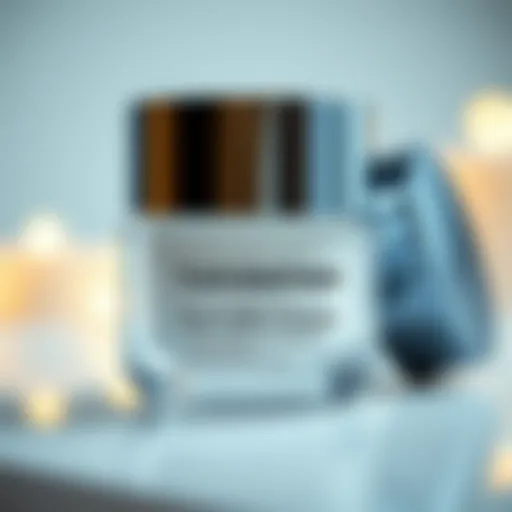Discover the Best Natural Sunless Tanners for Healthy Skin


Intro
As a growing number of individuals become aware of the dangers associated with UV exposure, the shift towards sunless tanning products has gained significant traction. This trend is fueled by a rising emphasis on skin health and the desire for a natural-looking glow without the risks that come from traditional tanning methods. Understanding the nuances involved in selecting the best sunless tanner is essential for achieving an authentic appearance. This guide seeks to offer insights into effective products, techniques, and considerations to help you find the perfect sunless tanner.
Tips and How-Tos
Understanding Skin Undertones
Choosing the right sunless tanner begins with understanding your skin undertone. This foundation plays a critical role in ensuring that the tanning product melts harmoniously into your skin. Skin undertones typically fall into three categories: cool, warm, and neutral.
- Cool undertones have hints of blue or pink. If your veins appear blue and you tend to burn easily in the sun, you may have a cool undertone. Products with a violet or blue base complement these tones well.
- Warm undertones showcase golden or peachy hues. Green or olive veins can indicate this undertone. Selecting a tanner with a golden or bronze base can achieve a radiant look.
- Neutral undertones feature a balance of both cool and warm tones. A versatile tanner might suit you best, allowing for an adaptable finish depending on the shades available.
Selecting Compatible Products
Not all sunless tanners are created equal. When shopping for a product, consider its formulation. Some popular options include:
- Mousses provide a lightweight, airy feel and typically dry quickly.
- Lotions offer a moisturizing effect and can be easier to spread.
- Gels often dry clear, ideal for those who wish to prevent staining clothes.
Additional considerations include:
- Allergen-Free and Vegan Options: Shoppers conscious of ingredients can find brands that emphasize natural components.
- Gradual Tanners: These products build a tan slowly over time, reducing the risk of an unnatural appearance for beginners.
Application Techniques
The method of application significantly determines the outcome of sunless tanning. Here are some practical tips:
- Exfoliate your skin before tanner application. This step helps achieve a smooth canvas and reduces patchiness.
- Moisturize dry areas, like elbows and knees, to avoid uneven absorption of the product.
- Use a mitt for application. This tool can help in distributing the tanner evenly and reduces the risk of stained palms.
- Practice streaking techniques. Applying with circular motions can avoid lines or patches.
- Allow time to dry. After applying, wait at least 15 to 30 minutes before dressing to ensure adequate drying.
"A good sunless tanner can enhance your confidence while keeping your skin health intact. It is all too important to choose one that complements your unique skin tone and type."
Skincare Routines for Different Skin Types
Integrating sunless tanners into your skincare regimen requires tailoring your routine based on your skin type. Consider these guidelines:
- Oily Skin: Opt for lightweight formulas. Look for oil-free tanners to prevent excess shine and help maintain a matte finish.
- Dry Skin: Use deeply hydrating products that include natural oils and humectants.
- Sensitive Skin: Seek tanners formulated without artificial dyes or fragrances to minimize irritation risks.
Understanding these differences can help create a personalized approach to achieving that coveted sun-kissed look.
Preamble to Sunless Tanning
In today's world, the demand for sunless tanning options has increased significantly. Many people prefer to maintain a bronzed appearance without the risks associated with UV exposure. Sunless tanners offer a viable alternative. They provide individuals a way to achieve the desired glow while prioritizing skin health, which is an essential consideration for anyone who values their appearance and wellbeing.
Understanding the Concept of Sunless Tanning
Sunless tanning refers to various products designed to give the skin a tanned look without direct sun exposure. These formulas typically contain substances that react chemically with the skin to produce a darker complexion. Dihydroxyacetone (DHA) is a common active ingredient in many of these products. It is a simple carbohydrate that interacts with the amino acids in the skin's surface. The result is a darker skin tone that mimics the effects of sun exposure.
It is important to choose products that deliver a natural-looking tan, as some formulations can leave behind an orange hue, which is often undesirable.
Benefits of Using Sunless Tanner
The use of sunless tanners presents numerous advantages compared to traditional tanning methods. Some of these benefits include:
- Skin Health: Sunless tanners eliminate the risks of sunburn and long-term damage, such as skin cancer.
- Immediate Results: Many products provide instant color or develop over a few hours, enabling immediate gratification.
- Customizable Depth: Users can control the shade they achieve by selecting different products or adjusting application amounts.
- Progressive Tans: With some formulations, users can build their tan gradually, allowing for a more subtle and natural appearance.
- Convenience: Sunless tanning products can be applied at home, saving time and ensuring privacy.
The benefits of sunless tanning extend beyond aesthetics; they advocate for better skin care habits. It encourages individuals to view tanning as an enhancement rather than a requirement, ultimately promoting healthier skin choices.
Types of Sunless Tanning Products
Understanding the types of sunless tanning products available is essential for those seeking that coveted natural glow. Each product type offers unique characteristics, application methods, and results. Knowing the differences can guide users towards selecting the most suitable option for their individual preferences and skin types.


Tanning Lotions
Tanning lotions are among the most common ways to achieve a sunless tan. They typically contain ingredients that react with the outer layer of the skin to create a tan. The consistency is often creamy, making them easy to apply evenly if done correctly. One significant advantage of tanning lotions is their moisturizing properties. Many brands infuse their formulations with hydrating agents, which help to keep skin smooth and prevent it from becoming dry. This is particularly important, as dry skin can lead to uneven color and patchiness.
However, proper technique is crucial while using tanning lotions to avoid streaks. Users should exfoliate before application and ensure an even spread to gain the best results.
Mousses and Gels
Mousses and gels are lighter alternatives to lotions. Their airy textures allow for rapid drying, which many find convenient. These products usually provide a more intense tan quickly, appealing to those who desire a deeper color without multiple applications. The application is often simpler, given the quick-drying nature that reduces the risk of smudging.
One downside is that mousses can sometimes feel sticky or tacky until they dry completely. Users should ensure that the application is uniformly distributed to avoid uneven patches, especially on the elbows and knees.
Sprays and Mists
Sprays and mists offer a fast and effortless application method. These products are distributed in a fine mist, making them suitable for reaching tricky areas. They are often preferred by individuals looking for convenience, especially when applying on the back or behind the knees.
One key consideration with sprays is the importance of controlling the distance from the skin. Too close can lead to dark spots, while too far can produce an uneven result. Additionally, users may need to stand in a well-ventilated area to avoid inhaling any of the fine particles.
Tanning Wipes
Tanning wipes are a portable alternative, ideal for travel or those on the go. They come pre-soaked in tanning solution, allowing for easy application. Users simply wipe the towelette across the skin for an instant tan. This makes them suitable for touch-ups or first-time applications without needing to handle liquids or creams.
The disadvantage is that they provide less control over application compared to lotions, mousses, or potentially even sprays. Wipes can lead to uneven patches if not used carefully, especially on larger areas. Despite these challenges, they are favored for their ease of use and convenience, making tanning straightforward, even in a rush.
Key Ingredients in Natural Looking Tanners
Understanding the ingredients in sunless tanners is vital for achieving a natural-looking tan. Some components are critical in determining the tone and longevity of the tan. Consumers should be informed about these key elements, as they play a significant role in how products interact with the skin. When selecting a tanner, it’s recommended to look for formulas that utilize quality ingredients that enhance skin health and provide a more realistic appearance.
Dihydroxyacetone (DHA)
Dihydroxyacetone, commonly known as DHA, is a fundamental ingredient in most sunless tanning products. It is a colorless sugar that reacts chemically with the amino acids on the skin's surface, resulting in a browning effect. This process is similar to the way skin darkens when exposed to sunlight. One of the significant advantages of DHA is that it essentially mimics the natural tanning process without exposure to harmful UV rays.
When using DHA-based tanners, it’s important to consider its concentration. Products with higher DHA levels may produce a darker tan, while lower concentrations yield a subtle glow. Also, applying DHA on exfoliated skin ensures an even and long-lasting result. Always check for any possible skin reactions, especially for individuals with sensitive skin.
Erythrulose
Erythrulose is another key ingredient that can enhance sunless tanners. It works similarly to DHA but has a slower reaction time. This means that while DHA may produce results quickly, erythrulose leads to a more gradual development of color. This slower process often results in a more evenly pigmented and natural-looking tan.
Importantly, when combined with DHA, erythrulose can help prolong the duration of the tan. It gives a depth of color that is often considered more appealing. Users might find that tanners containing both DHA and erythrulose tend to fade more gracefully. Those who seek a natural sunless tan should consider looking closely at the ingredient list for products that include erythrulose.
Natural Oils and Extracts
The inclusion of natural oils and extracts in sunless tanners is becoming increasingly popular. These ingredients not only offer nourishment to the skin but also enhance the tanning experience. Natural oils, like coconut oil and jojoba oil, help in moisturizing the skin, making it less likely to dry out or feel uncomfortable after application. Additionally, these oils contribute to a smoother application, reducing streaks and patches.
Extracts such as aloe vera and green tea are also beneficial. They have soothing properties and can help calm the skin, which is especially important for those prone to irritation. Furthermore, these natural components can aid in the overall health of the skin, ensuring it remains hydrated and vibrant.
Incorporating sunless tanners with natural oils and extracts promotes healthy skin while achieving a bronzed look. As consumers become more conscious of the ingredients in their beauty products, choosing tanners that include these enriching elements can lead to better skin health and a more radiant appearance.
"Understanding these key ingredients can help users make informed choices about their sunless tanning products, leading to a natural and appealing look."
By focusing on these core ingredients—DHA, erythrulose, and natural oils and extracts—consumers can discern which products will best serve their skincare needs while providing a believable tan.
Selecting the Right Sunless Tanner
Selecting the right sunless tanner is essential for achieving a believable and flattering glow. Various factors come into play, and understanding them enhances the overall tanning experience. It is about more than just choosing a product; it's an investment in one’s appearance and skincare health.
Getting it right can save time and frustration while preventing potential mishaps. Choosing a suitable sunless tanner ensures the final look will be natural, avoiding unwanted orange tones or uneven patches. Moreover, the right tanner can support skin health, avoiding ingredients that provoke irritation or allergic reactions. Thus, making an informed decision is vital.


One key aspect is skin undertones. Selecting a tanner that complements an individual’s natural skin tone can substantially affect the result. This section will highlight how to assess these undertones effectively. Additionally, selecting the appropriate shade is just as important, particularly since various products come in a range of hues.
In summary, selecting the right sunless tanner involves understanding both skin undertones and shades. This process can enhance the overall outcome and also reflect one’s unique style and personality.
Assessing Skin Undertones
Skin undertones play a crucial role in selecting the right sunless tanner. Undertones are the subtle hues beneath the skin's surface that affect the overall tone. Knowing whether one has warm, cool, or neutral undertones can guide the choice of tanning products.
- Warm undertones often have a golden, yellow, or peach base. For these individuals, products with warm tones work best.
- Cool undertones usually display pink, red, or blue hues. Here, tanners with cool undertones compliment the skin.
- Neutral undertones have a balance of both warm and cool tones. These individuals can often use a wider range of products.
A practical way to assess undertones is to look at the veins in the wrist. If they appear green, warm undertones are likely present. If they look blue or purple, cool undertones are more dominant. If it's unclear, one may have neutral undertones.
Choosing the Appropriate Shade
Choosing the appropriate shade for a sunless tanner can significantly affect the outcome. Different products offer various shades, from light to deep bronze. It is essential to consider the desired result and how it aligns with one’s skin tone.
- For a natural look, it is often best to choose a shade that is one or two shades darker than the natural skin color.
- Testing a small area before full application helps determine how the tanner reacts with the skin.
- Reading reviews or seeking expert opinions can also aid in selecting the right product, providing insight into how specific shades appear on various skin tones.
Despite the temptation to go for a darker shade instantly, it is more effective in building color gradually. This approach helps in achieving a more natural and flattering appearance.
Application Techniques for a Flawless Finish
Achieving a flawless application of sunless tanner is crucial for obtaining that desired natural glow. The right techniques can enhance the efficacy of the product, ensuring even coverage and minimizing any chances of streaks or discoloration. Understanding how to properly apply tanner not only maximizes results but also contributes to a more satisfying user experience, promoting the confidence in one's appearance. This section breaks down essential techniques for successful sunless tanning, offering detailed insights into preparation, application, and tips for difficult areas.
Prep Work: Exfoliation and Moisturizing
Proper preparation of the skin is the foundation for a flawless tan. Before applying any sunless product, exfoliation must be undertaken. This process helps to slough off dead skin cells, resulting in a smoother surface for the tanner to adhere to. Key methods of exfoliating include using body scrubs, exfoliating gloves, or chemicals designed for gentle peeling. Target areas such as elbows, knees, and ankles, as they tend to accumulate dry skin.
After exfoliation, moisturizing is essential. Applying a lightweight moisturizer hydrates the skin and aids in creating an even base for tanning. Opt for non-oily formulas. This will help prevent the tanning solution from settling into dry patches, which can lead to an uneven application. It's important to pay extra attention to areas that may be prone to dryness but to allow sufficient time for the moisturizer to absorb before proceeding with the tanner.
Applying the Tanner Evenly
Once the skin is prepped, the next phase is the application of the tanner itself. Start with clean hands or use gloves to prevent staining palms. Begin at the ankles or feet and work upward. This directional approach helps manage any potential unevenness, as lower areas often receive more product. Using circular motions ensures that the tanner spreads evenly across the skin.
It is recommended to apply the product in thin layers to avoid buildup. After the initial application, assess the coverage. If the shade isn't as deep as desired, wait for the product to develop before adding more layers. Also, keep an eye on sensitive areas like the face and neck, where a lighter touch is often more flattering. With practice, developing a routine for a consistent application will become second nature.
Tips for Hard-to-Reach Areas
Certain areas of the body can pose challenges during tanning, particularly spots like the back and back of the legs. Strategies to address these difficulties include using long-handled applicators or asking a partner for assistance. Moreover, using a tanning mitt can provide a better grip and control over the application.
Spots such as the elbows, knees, and knuckles require special attention. A common tip is to lightly moisturize these areas before application, which helps lessen absorption and reduces the risk of over-tanning. For underarms and behind the ears, ensure that the product is applied lightly, as these spots can easily look too dark if too much tanner is applied.
Remember, practice makes perfect. With each application, you’ll refine your technique and achieve a better outcome.
By focusing on these application techniques, you can ensure a more radiant and natural-looking tan while enhancing the overall enjoyment of using sunless tanners.
Aftercare for Extended Wear
Aftercare plays a crucial role in the longevity and appearance of your sunless tan. Proper post-application care not only maintains the color but also enhances your skin's overall health and glow. Neglecting aftercare can lead to uneven fading or even patchiness, detracting from the desired natural look. Understanding the necessary steps ensures that your tan lasts longer while preserving your skin's integrity.
Moisturizing to Maintain Color
Moisturizing is essential for keeping your tan fresh and vibrant. Sunless tanning products often can dry out the skin, causing the color to fade more rapidly. Therefore, a diligent moisturizing routine helps to lock in hydration, preventing the tan from looking dull or uneven.
Using a good quality moisturizer that is free of alcohol is advisable. Many moisturizers contain ingredients like aloe vera or shea butter, which both hydrate and soothe the skin. It is recommended to apply moisturizer daily. Focusing on areas that tend to be drier, such as elbows and knees, can help maintain an even skin tone.
In addition to regular moisturizing, consider using self-tanning maintenance products. Brands such as St. Tropez and Jergens offer gradual tanners that can seamlessly blend with your existing tan and restore its glow.


Avoiding Common Pitfalls
There are several common pitfalls that individuals face when using sunless tanners. Addressing these can make a significant difference in your tanning experience and outcome.
- Over-exfoliating: While exfoliation is important before applying tanner, overdoing it can strip away the upper layers of your skin, leading to patchiness. Stick to gentle exfoliation one to two days prior to application.
- Using the Wrong Products: Not every lotion or cream is suitable for maintaining a fake tan. Check for products made specifically for this purpose. Avoid any formulas with exfoliating agents, which can inadvertently fade your tan more quickly.
- Skipping Hydration: Dehydration can cause skin to flake, resulting in uneven fading of the tan. Always hydrate from the inside out by drinking plenty of water, in addition to your skincare routine.
- Ignoring Touch-Ups: A sunless tan doesn’t last indefinitely. Regular touch-ups can help maintain a consistent color. Pay attention to areas that fade faster, like hands and feet.
"Regular maintenance is key to achieving that flawless sun-kissed glow. Don't skip your aftercare routine!"
By avoiding these pitfalls, you can enhance your overall tanning experience. Taking the time to focus on aftercare can greatly improve your satisfaction with sunless tanning results.
Top Recommendations for Natural Looking Sunless Tanners
Selecting the right sunless tanner can significantly influence the final result of the application process. The objective is to achieve a natural-looking glow while ensuring skin health. This section presents recommendations based on product reviews and expert opinions, which are vital for effective use and satisfaction.
Product Reviews and Comparisons
When it comes to sunless tanners, no two products are identical. One may offer a better formulation than others, leading to a more natural finish. The key is identifying products that have been thoroughly tested and reviewed by users.
- St. Tropez Self Tan Classic Bronzing Mousse: This product is often praised for its easy application and natural results. It dries quickly and adapts well to various skin tones, making it a favorite among both casual users and tanning enthusiasts.
- Vita Liberata Phenomenal 2-3 Week Tan Lotion: Known for its longevity, this lotion offers a brown tone that mimics a real tan. Reviews emphasize its hydrating qualities and minimal odor, factors that many users find appealing.
- Bondi Sands Self Tanning Foam: This foam delivers an Australian-inspired tan with a natural olive undertone. Users frequently comment on its smooth application process and quick drying time, which sets it apart from other products.
"The right sunless tanner not only enhances appearance but also boosts confidence."
These reviews highlight essential factors such as ease of use, drying time, skin tone matching, and longevity of the tan. Comparisons between these products provide a clearer picture for readers who want to make informed choices.
Expert Opinions on Effectiveness
Expert insights lend credibility to the evaluation of sunless tanners. Many skincare professionals emphasize the importance of ingredients and formulation when selecting a product. A common recommendation from dermatologists is to opt for products containing Dihydroxyacetone (DHA), as this ingredient is the primary active component responsible for tanning without the damaging effects of UV exposure.
Experts also advise considering the following:
- Skin Compatibility: Select a tanner based on skin type. Sensitive skin often benefits from products with natural ingredients.
- Color Development Time: Many experts suggest looking for tanners that develop over a few hours, as they often yield more natural and gradual results.
- Ease of Removal: An effective sunless tanner should be easily removable. Products that fade evenly and can be exfoliated away are usually favored by professionals.
Evaluating sunless tanners based on expert opinions ensures that users are not only satisfied with their appearance but also making choices that are good for their skin health over time. Overall, these recommendations and expert insights create a roadmap for achieving a natural-looking sunless tan.
Sustainability in Sunless Tanning
Sustainability is becoming an essential factor in today's beauty industry, and sunless tanning products are no exception. As consumers grow more conscious of their environmental impact, brands increasingly prioritize eco-friendly practices. This section explores why sustainability in sunless tanning matters, especially considering the ingredients used and their effects on both our skin and the planet.
Eco-Friendly Formulations
Eco-friendly formulations are those that minimize harm to the environment. This can include sourcing ingredients sustainably, using plant-based components, and ensuring that production methods do not deplete natural resources. Ingredients like Dihydroxyacetone (DHA) can be derived from sugar beets or sugar cane, which are renewable resources.
Moreover, brands are pushing to eliminate harmful chemicals that can leach into soil and water systems. When choosing a sunless tanner, look for those that specify using safe, biodegradable ingredients. Certifying labels such as organic or cruelty-free can also indicate a more sustainable approach.
"Choosing eco-friendly tanning products helps reduce the overall environmental footprint while promoting personal health."
Responsible Usage and Waste Reduction
Another crucial aspect of sustainability in sunless tanning is responsible usage and waste reduction. Many consumers may not consider how they apply and dispose of tanning products. One practical approach is using the correct amount of product. Over application not only wastes the product but also leads to uneven results that require more product to correct.
Using reusable applicators or gloves can further reduce waste compared to single-use items. Additionally, consider proper disposal methods for packaging. Recycling containers and opting for brands that use minimal or recyclable packaging can make a significant difference.
To summarize, being mindful of sustainability when selecting sunless tanning products not only benefits the environment but can also enhance the quality of the product. By making informed choices, consumers contribute to a healthier planet while enjoying a natural-looking tan.
The End
The conclusion of this article is crucial in encapsulating the various aspects of sunless tanning. It reflects on the importance of adopting a safe and effective approach to achieving that radiant glow many desire. With the myriad of sunless tanner options available today, understanding how to select the right product and applying it correctly is essential for optimal results.
By summarizing key takeaways, this section reinforces the significance of factors such as skin undertones and product formulations. Such considerations help in creating a natural look while avoiding the common pitfalls associated with tanning products. Moreover, the subsequent emphasis on sustainability highlights the shifting focus towards eco-friendly practices, ensuring that beauty routines align with personal values regarding the environment.
Here are some key points summarized in this section:
- Understanding Product Choices: Not all products work equally well for every skin type. It is crucial to choose based on individual skin tone and preferences.
- Application Techniques: Proper application can be the difference between a streaky finish and a flawless tan. Techniques like proper exfoliation and thorough moisturizing help achieve a uniform result.
- Maintenance: Incorporating aftercare steps such as regular moisturizing extends the longevity of the tan.
- Sustainability: With rising awareness about environmental impact, many consumers prefer brands that offer eco-friendly tanning options that do not compromise on effectiveness.
"A natural-looking tan should enhance, not overpower. Prioritize quality ingredients and responsible choices for best results."







